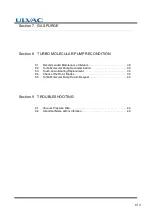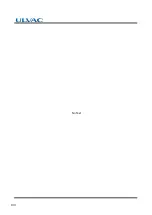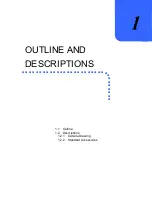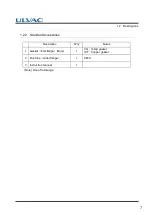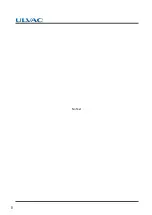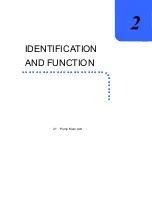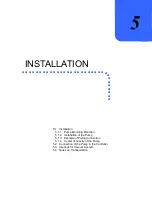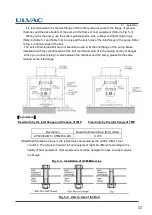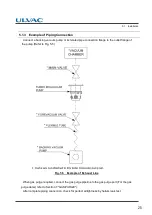
12
SECTION 3
CONSTRUCTION AND PRINCIPLE
3.1
Pump Construction
Fig. 3-1 is a sectional drawing of UTM-MS series magnetic bearing type turbo molecular pump.
The built-in high frequency motor (1) is accelerated to the specified revolutions (speed) by the high
frequency controller. Rotor blades (4) are fitted onto the drive shaft (3) and the stator blades (5) are
arranged in between the rotor blades. A positioning spacer (6) is inserted between the stator
blades. The configurations and profiles of the stator blades and rotor blades are designed for high
efficiencies in various applications. The upper stages of the rotor blade and stator blade
configurations are ideally designed for high gas throughput. The compression ratio of the stator
blades and rotor blades becomes higher as the gas molecules converge into the lower stage
configurations. The profiles of the stator blades and rotor blades are matched for the desired
function.A radial magnetic bearing (7) is used at the top and bottom of the drive shaft. The axial
magnetic bearings (8) are used to levitate a disk attached to the drive shaft between the axial
magnetic bearings. Each magnetic bearing is provided with a gap sensor (10) to detect the rotor
position. Fig. 3-2 illustrates the outline of 5-axes control. The rotor is levitated by the control of these
5-axes allowing rotational freedom.
A touchdown bearing is used at the top and bottom of the casing for safety protection of the rotor
and pump should the magnetic bearings become damaged. The touchdown bearings are dry and oil
free.
The cooling water pipe (14) is provided to cool the pump.
With the air-cooled turbo molecular
pumps, cooling fans are provided instead of the cooling water pipe (14).
3.2
Principle of Turbo Molecular Pumping
The principle of turbo molecular pumping assumes gas molecules collide with a surface plane
(the blade of the pump rotor) moving in a radial span of very high speed in a space with an
enlarged mean free gas path (generally a vacuum area of less pressure than 0.1 Pa). Assuming
no heat is exchanged between the gas molecule and the pump rotor blade, the speed of the
pump rotor blade is added to the speed of the gas molecule, converting the gas molecule's non-
oriented thermal motion to a motion with direction. Thus the gas molecule has received an impulse
in a desired flow direction.
Summary of Contents for UTM-MS Series
Page 2: ...No Text...
Page 9: ...vii Introduction Location of Label...
Page 12: ...x No Text...
Page 16: ...xiv No Text...
Page 24: ...8 No Text...
Page 25: ...2 1 Pump Main Unit IDENTIFICATION AND FUNCTION...
Page 27: ...3 1 Pump Construction 3 2 Principle of Turbo Molecular Pumping CONSTRUCTION AND PRINCIPLE...
Page 31: ...4 1 Standard Specifications for Pump Unit SPECIFICATIONS...
Page 34: ...18 No Text...
Page 50: ...34 No Text...
Page 51: ...GAS PURGE...
Page 58: ...42 No Text...
Page 59: ...9 1 Vacuum Pressure Rise 9 2 Abnormal Noise and or Vibration TROUBLESHOOTING...


